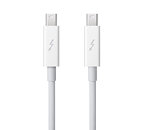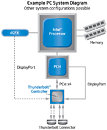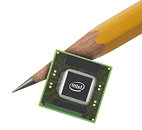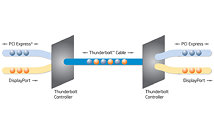Thursday, February 24th 2011

Thunderbolt Technology: The Fastest Data Connection to Your PC Just Arrived
Intel Corporation today announced the availability of Thunderbolt technology, a new high-speed PC connection technology that brings together high-speed data transfer and high-definition (HD) display on to a single cable. Running at 10 Gbps, Thunderbolt technology can transfer a full-length HD movie in less than 30 seconds. This Intel-developed technology is coming to market through a technical collaboration with Apple, and is available first on Apple's new line of MacBook Pro laptop computers.
The vision for Thunderbolt technology (formerly codenamed "Light Peak") is to move media faster, simplify connections between devices, and foster new and exciting ways to build and use PCs. Combining high-speed data and HD video connections together onto a single cable is instrumental to achieving that vision. Thunderbolt technology delivers this via two communications methods, or protocols -- PCI Express for data transfer and DisplayPort for displays.PCI Express has the flexibility to connect to almost any type of device, and DisplayPort can drive greater than 1080p resolution displays and up to eight channels of audio simultaneously. Thunderbolt technology is compatible with existing DisplayPort displays and adapters. All Thunderbolt technology devices share a common connector, and let individuals simply daisy-chain their devices one after another, connected by electrical or optical cables.
Thunderbolt technology is designed to meet the demands of serious HD media creators. For example, videographers can unleash their creativity using high-bandwidth audio and video capture/mixing devices, and get both low latency and highly-accurate time synchronization for real-time processing. At 10Gbps, larger media files are transferred faster so there's less time spent waiting to watch and edit videos. Data can be backed up and restored quicker, so there's less waiting for archived content. For mobile PC users, it means having a single connector on their ultra-thin laptop that extends their high-speed media and HD display capabilities at home or in the office. Thunderbolt technology is complementary to other I/O technologies that Intel continues to support."Working with HD media is one of the most demanding things people do with their PCs," said Mooly Eden, general manager, PC Client Group, Intel. "With Thunderbolt technology, Intel has delivered innovative technology to help professionals and consumers work faster and more easily with their growing collection of media content, from music to HD movies. We've taken the vision of simple, fast transfer of content between PCs and devices, and made it a reality."
"We're thrilled to collaborate with Intel to bring the groundbreaking Thunderbolt technology to Mac users," said Bob Mansfield, Apple's senior vice president of Mac Hardware Engineering. "With ultra-fast transfer speeds, support for high-resolution displays and compatibility with existing I/O technologies, Thunderbolt is a breakthrough for the entire industry and we think developers are going to have a blast with it."
Thunderbolt technology is powered by an Intel controller chip, and uses a small connector suitable for mobile devices that will be included in products supporting the technology. Several innovative companies have announced Thunderbolt technology-based products, or currently plan to support Thunderbolt technology in upcoming products, including Aja, Apogee, Avid, Blackmagic, LaCie, Promise, and Western Digital. Intel is working with the industry on a range of Thunderbolt technology-enabled products including computers, displays, storage devices, audio/video devices, cameras, docking stations and more.
The vision for Thunderbolt technology (formerly codenamed "Light Peak") is to move media faster, simplify connections between devices, and foster new and exciting ways to build and use PCs. Combining high-speed data and HD video connections together onto a single cable is instrumental to achieving that vision. Thunderbolt technology delivers this via two communications methods, or protocols -- PCI Express for data transfer and DisplayPort for displays.PCI Express has the flexibility to connect to almost any type of device, and DisplayPort can drive greater than 1080p resolution displays and up to eight channels of audio simultaneously. Thunderbolt technology is compatible with existing DisplayPort displays and adapters. All Thunderbolt technology devices share a common connector, and let individuals simply daisy-chain their devices one after another, connected by electrical or optical cables.
Thunderbolt technology is designed to meet the demands of serious HD media creators. For example, videographers can unleash their creativity using high-bandwidth audio and video capture/mixing devices, and get both low latency and highly-accurate time synchronization for real-time processing. At 10Gbps, larger media files are transferred faster so there's less time spent waiting to watch and edit videos. Data can be backed up and restored quicker, so there's less waiting for archived content. For mobile PC users, it means having a single connector on their ultra-thin laptop that extends their high-speed media and HD display capabilities at home or in the office. Thunderbolt technology is complementary to other I/O technologies that Intel continues to support."Working with HD media is one of the most demanding things people do with their PCs," said Mooly Eden, general manager, PC Client Group, Intel. "With Thunderbolt technology, Intel has delivered innovative technology to help professionals and consumers work faster and more easily with their growing collection of media content, from music to HD movies. We've taken the vision of simple, fast transfer of content between PCs and devices, and made it a reality."
"We're thrilled to collaborate with Intel to bring the groundbreaking Thunderbolt technology to Mac users," said Bob Mansfield, Apple's senior vice president of Mac Hardware Engineering. "With ultra-fast transfer speeds, support for high-resolution displays and compatibility with existing I/O technologies, Thunderbolt is a breakthrough for the entire industry and we think developers are going to have a blast with it."
Thunderbolt technology is powered by an Intel controller chip, and uses a small connector suitable for mobile devices that will be included in products supporting the technology. Several innovative companies have announced Thunderbolt technology-based products, or currently plan to support Thunderbolt technology in upcoming products, including Aja, Apogee, Avid, Blackmagic, LaCie, Promise, and Western Digital. Intel is working with the industry on a range of Thunderbolt technology-enabled products including computers, displays, storage devices, audio/video devices, cameras, docking stations and more.





76 Comments on Thunderbolt Technology: The Fastest Data Connection to Your PC Just Arrived
Think of how fast USB 3.0 came onto the market, oh wait, it is still not mainstream yet.
We will need to wait for 5 years before we actually know whether this is a success or destinied to fail like Firewire.
Edit: I am not impressed, Bta: "OMFG looks, Thunderbolt connector! Let me try to plug my device through this superfast connector... oh, wait.... FUUUUUUUU...."
On the other hand, USB3.0: "hmm, this looks like a blue USB port." *le plug in* "oh, it works :3 "
But to be honest, it doesn't look that impressive. It just combines the 4x free pci-e lanes from the south bridge and a display port into a single connector. I guess the only revolutionary thing is how damn small they made it :]
I imagine Thunderbolt with its 1536 MB/s bandwidth having more market longevity (perhaps for the first half of this decade), compared to USB 3.0 with its 480 MB/s bandwidth, which is already bottlenecking 500+ MB/s SATA 6 Gb/s SSDs in USB 3.0 enclosures.
alltho, we have no servers yet with more than 10...alltho our core switch got 100.
Leap Ahead
This is also an interesting way to interconnect servers. A comms link significantly faster than gigabit and without the horrendous expense of 10G network and 10G switches.
In fact, the interconnect is fast enough to stick CPU/rendering resources at the other end. "Join" your PC to your laptop, or indeed two or more PC's together to great an inter-workstation.
Expect to see workstations with two thunderbolt ports.
You can't force a company to create or support a technology if they do not want to.
I don't see the problem in an external peripheral connector bottlenecking an 8-HDD RAID-0 array or a top-end SSD. If you have 1,000$ to spend on storage, you're not going to use USB.
OT:
I don't know what to think of this in general.
It seems to be the norm to have a competing interface that's only 2-3x as fast.
Firewire's 800Mbps vs USB 2.0's 480Mbps vs LAN's 1,000Mbps.
Now we have Firewire's 6,400Mbps vs USB 3.0's 4,800Mbps vs Thuderbolt's 10,000Mbps.
USB 4.0's 48,000Mbps vs Thunderbolts 2.0's 100,000Mbps is not necessary.
I think everyone's needs can be met with USB.